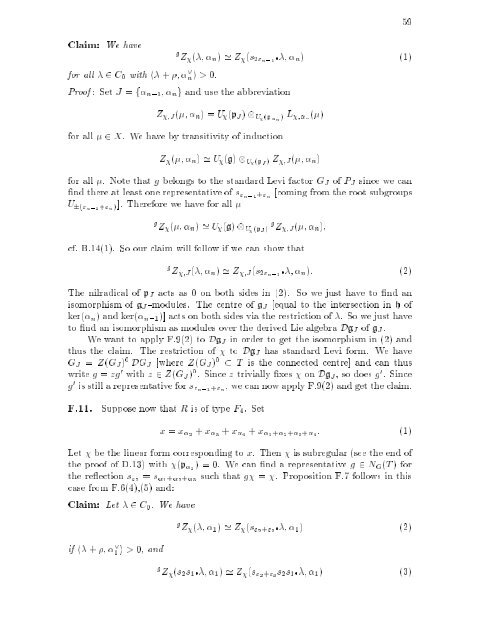subregular nilpotent representations of lie algebras in prime ...
subregular nilpotent representations of lie algebras in prime ...
subregular nilpotent representations of lie algebras in prime ...
Create successful ePaper yourself
Turn your PDF publications into a flip-book with our unique Google optimized e-Paper software.
Claim: We have<br />
for all 2 C0 with h + ; _ ni > 0.<br />
g Z ( ; n) ' Z (s2"n,1 ; n) (1)<br />
Pro<strong>of</strong> : Set J = f n,1; ng and use the abbreviation<br />
Z ;J( ; n) =U (pJ) U (p n ) L ; n( )<br />
for all 2 X. Wehave by transitivity <strong>of</strong> <strong>in</strong>duction<br />
Z ( ; n) ' U (g) U (pJ ) Z ;J( ; n)<br />
for all . Note that g belongs to the standard Levi factor GJ <strong>of</strong> PJ s<strong>in</strong>ce we can<br />
nd there at least one representative <strong>of</strong>s"n,1+"n [com<strong>in</strong>g from the root subgroups<br />
U ("n,1+"n)]. Therefore we have for all<br />
g Z ( ; n) ' U (g) U (pJ) g Z ;J( ; n);<br />
cf. B.14(1). So our claim will follow ifwe can show that<br />
g Z ;J( ; n) ' Z ;J(s2"n,1 ; n): (2)<br />
The nilradical <strong>of</strong> pJ acts as 0 on both sides <strong>in</strong> (2). So we just have to nd an<br />
isomorphism <strong>of</strong> gJ{modules. The centre <strong>of</strong> gJ [equal to the <strong>in</strong>tersection <strong>in</strong> h <strong>of</strong><br />
ker( n) and ker( n,1)] acts on both sides via the restriction <strong>of</strong> .Sowejusthave<br />
to nd an isomorphism as modules over the derived Lie algebra DgJ <strong>of</strong> gJ.<br />
We want to apply F.9(2) to DgJ <strong>in</strong> order to get the isomorphism <strong>in</strong> (2) and<br />
thus the claim. The restriction <strong>of</strong> to DgJ has standard Levi form. We have<br />
GJ = Z(GJ) 0 DGJ [where Z(GJ) 0 T is the connected centre] and can thus<br />
write g = zg 0 with z 2 Z(GJ) 0 . S<strong>in</strong>ce z trivially xes on DgJ, sodoesg 0 . S<strong>in</strong>ce<br />
g 0 is still a representative fors"n,1+"n, we can now apply F.9(2) and get the claim.<br />
F.11. Suppose now that R is <strong>of</strong> type F4. Set<br />
x = x 2 + x 3 + x 4 + x 1+ 2+ 3+ 4: (1)<br />
Let be the l<strong>in</strong>ear form correspond<strong>in</strong>g to x. Then is <strong>subregular</strong> (see the end <strong>of</strong><br />
the pro<strong>of</strong> <strong>of</strong> D.13) with (p 1) = 0. We can nd a representative g 2 NG(T ) for<br />
the re ection s"2 = s 1+ 2+ 3 such that g = . Proposition F.7 follows <strong>in</strong> this<br />
case from F.6(4),(5) and:<br />
Claim: Let 2 C0. We have<br />
if h + ; _ 1 i > 0, and<br />
g Z ( ; 1) ' Z (s"2+"3 ; 1) (2)<br />
g Z (s2s1 ; 1) ' Z (s"2+"3s2s1 ; 1) (3)<br />
59

















